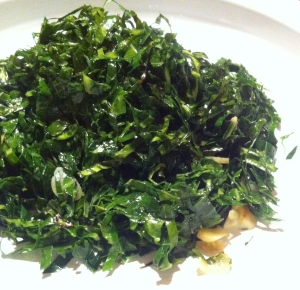
Feijão tropeiro is quintessentially Brazilian, quintessentially mineiro. I loved meeting the feijão tropeiro in New York City, in one of those chic churrascarias at Central Park West. I looked at the unpretentious dish on the buffet table, not dressed up in some mango chutney or ornate with cilantro and cayenne guacamole foam. It mingled comfortably among the parade of skewered meats, plainly beautiful as it was born among the hills of Minas Gerais during the gold rush era.
The name tropeiro comes from trooper, but it relates to a private group of gentlemen transporting goods for sale on horseback through a vast region. It is said that “trooperism” was initiated in Brazil by the Portuguese Crown, to transport the gold extracted in Minas Gerais to the ports in Rio de Janeiro. The Brazilian tropeiro transported more than goods for sale; he transported cultures and the practice of “coming and going” through the passageways and roads they created.
The rustic troopers’ bean dish has been a staple in Brazilian cuisine since colonial times. The mixture of sausage, bacon, and onions with cooked beans and yucca flour was easily prepared on the sides of roads, by those pioneers, circa 1695. The feijão tropeiro still endured its same characteristics as it sat there, in a sophisticated restaurant on the island of Manhattan – demanding a price of the gold nuggets of its time. I wanted to high-five my fellow citizen, but searched, instead, for my compatriot credentials.
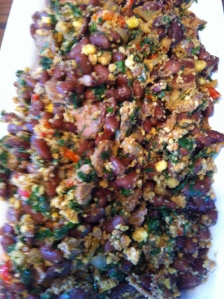 I experienced the tropeiros’ bean dish all through my life; although with less frequency on this side of the Atlantic, I have managed to keep its presence alive in my kitchen. The comfort and safety inspired by its steadiness bears the family allegiance. From a childhood with siblings, through doubtful adolescence, to the conventional rites of passages into adulthood, this food is a safe port through my journey. Today, I will post a traditional feijão tropeiro recipe, but in the photos posted here I have replaced the yucca flour with cornbread flour. Some people in my family might consider the replacement as sacrilegious, but it is Labor Day Weekend and I’ve promised feijão tropeiro to few friends gathering for a barbecue. I first manipulated the dish’s characteristics when I lived in Sullivan County, New York, informally known as the Jewish Alps, with not a single chance to get my hands on yucca flour, alien to the region. Every time I do so, I am careful enough to introduce it as a tropeiro-style bean dish. Serve your feijão tropeiro as a side dish with barbecued beef or roasted pork.
I experienced the tropeiros’ bean dish all through my life; although with less frequency on this side of the Atlantic, I have managed to keep its presence alive in my kitchen. The comfort and safety inspired by its steadiness bears the family allegiance. From a childhood with siblings, through doubtful adolescence, to the conventional rites of passages into adulthood, this food is a safe port through my journey. Today, I will post a traditional feijão tropeiro recipe, but in the photos posted here I have replaced the yucca flour with cornbread flour. Some people in my family might consider the replacement as sacrilegious, but it is Labor Day Weekend and I’ve promised feijão tropeiro to few friends gathering for a barbecue. I first manipulated the dish’s characteristics when I lived in Sullivan County, New York, informally known as the Jewish Alps, with not a single chance to get my hands on yucca flour, alien to the region. Every time I do so, I am careful enough to introduce it as a tropeiro-style bean dish. Serve your feijão tropeiro as a side dish with barbecued beef or roasted pork.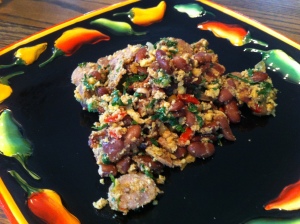
The tropeiro bean dish may be the proudest expat dish among my cronies. Without the Brazilian forofa’s versatility, that dresses up or down according to the event, the feijão tropeiro does not take adorns. It is as Brazilian as Carmen Miranda, though too abstemious to adopt the fruity hat.
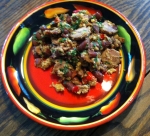



Ingredients
- 1 lb red beans
- 10 medium collard greens leaves, cut very thin
- 1/2 lb bacon, chopped and fried
- 1/2 lb your favorite sausage, cooked and sliced thin ( what kind of saysage)
- 1 large onion, chopped
- 5 cloves garlic, chopped
- Salt and pepper to taste
- 3 fried eggs, cut up
- Chopped parsley and scallion to taste
- 2 cups yucca flour
- 3 hard boiled eggs, chopped
- 1/3 cup olive oil
Directions
- Wash and cook the beans until soft, but not breaking apart, about 30 min. Drain it and set aside
- In a medium skillet sauté the collard greens for about 5 min. Set aside
- In a large heavy bottom pot, heat the bacon and sausage; add onion and garlic. Saute until onion is soft.
- Add the reserved beans and collards – add salt and pepper
- Add cut up fried eggs, parsley and scallion
- Mix in the yucca flour slowly, making sure the mixture is evenly coated (you can use more or less yucca flour depending on how moist you prefer your feijão tropeiro).
- Sprinkle the hard boiled eggs and olive oil on top before serving – serves 6-8

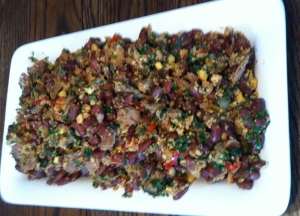

 Street food in Brazil has the festive personality of sambas and the erudite composure of operas; in other words, it is quintessentially Brazilian. The famous trio: Empadinhas, Coxinhas and Pasteis are congenial democrats mingling in every street-fair, and also scholars reveling in lavish soirées.
Street food in Brazil has the festive personality of sambas and the erudite composure of operas; in other words, it is quintessentially Brazilian. The famous trio: Empadinhas, Coxinhas and Pasteis are congenial democrats mingling in every street-fair, and also scholars reveling in lavish soirées.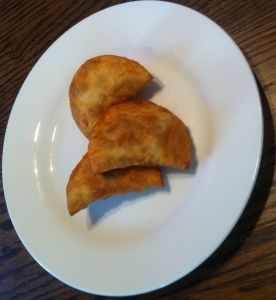
 In my kitchen I make a smaller and lighter version of coxinhas and empadinhas, but the pastel is full fledged street smart: not only does their size matter, but also their unabashedly thick crust and their robust filling of meat and potatoes. The leftover cold and deflated pastel is the ultimate morning-after food.
In my kitchen I make a smaller and lighter version of coxinhas and empadinhas, but the pastel is full fledged street smart: not only does their size matter, but also their unabashedly thick crust and their robust filling of meat and potatoes. The leftover cold and deflated pastel is the ultimate morning-after food.
 Street food in Brazil has the festive personality of sambas and the erudite composure of operas; in other words, it is quintessentially Brazilian. The famous trio: Empadinhas, Coxinhas and Pasteis are congenial democrats mingling in every street-fair, and also scholars reveling in lavish soirées.
Street food in Brazil has the festive personality of sambas and the erudite composure of operas; in other words, it is quintessentially Brazilian. The famous trio: Empadinhas, Coxinhas and Pasteis are congenial democrats mingling in every street-fair, and also scholars reveling in lavish soirées.

 In my kitchen I make a smaller and lighter version of coxinhas and empadinhas, but the pastel is full fledged street smart: not only does their size matter, but also their unabashedly thick crust and their robust filling of meat and potatoes. The leftover cold and deflated pastel is the ultimate morning-after food.
In my kitchen I make a smaller and lighter version of coxinhas and empadinhas, but the pastel is full fledged street smart: not only does their size matter, but also their unabashedly thick crust and their robust filling of meat and potatoes. The leftover cold and deflated pastel is the ultimate morning-after food.
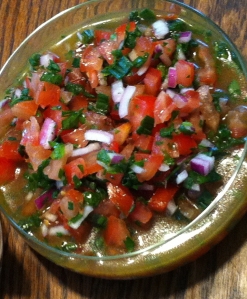 3 cups tomatoes seeded diced
3 cups tomatoes seeded diced